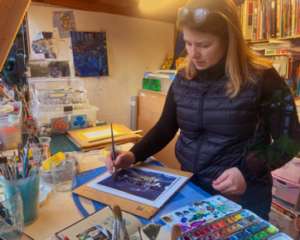Learn Watercolour Techniques online with Gail Astbury. In this six week course we explore the techniques used by artists who are members of the Royal Watercolour Society and take inspiration from their work.
Mondays 2 – 4.15pm
12 April – 17 May
Course Fee: £120 (£90 Concessions)
Limited to 10 artists
Online
The Royal Watercolour Society was founded in 1804 and is one of the oldest and most prestigious watercolour societies in the world. Henry Moore and John Singer Sargent were members. The Society is led by artists who are elected to become members. The artists are some of the finest practitioners in contemporary water-based painting today and are elected on merit by the existing membership. There are only 75 artists members at any time. They hold two exhibitions a year and all their work is for sale.
This 6 week course led by Gail Astbury is your opportunity to learn watercolour techniques online. Before the session we send you support notes which Gail has prepared. We record the session so you can play it back as you create your own works of art.
Course Content
Week 1: Sue Howells
“I don’t usually plan my paintings in
Sue Howells
advance. Starting with a loose wash, I let one brush stroke lead to another, always looking for the perfect composition, cropping along the way to get the right balance. The enjoyment of using pure watercolour is important to me, exploiting the effect of this elusive medium, letting the beauty of the paper.”

Week 2: Francis Bowyer
“Light and colour play an important
Francis Bowyer
part in my paintings. The brief moment captured. A richness and enjoyment of colour is always at the heart of the subjects that I am attracted to.”

Week 3: Emma Howarth
Emma’s paintings are narratives, usually based in a park or scrub land set within an urban environment. These areas are havens for people and wildlife, places of sanctuary and refuge from the city. Such spaces are a constantly changing back drop with the seasons, weather and passage of time affecting all that passes through them.

Week 4: Christopher le Brun
He is an honorary member of the RWS . His work is characterised by an adherence to the essential values of touch, light, space and colour while maintaining a questioning and strongly individual stance in relation to contemporary art history. Though abstract in appearance, his art is rooted in the long tradition of the English appreciation of landscape and nature.

Week 5: Angie Lewin
Angie often returns to the same places for her walking and sketching trips. She collects natural elements like seedpods, grasses, pebbles, dried seaweed and feathers, which she takes back to her studio. These reminders of familiar, but ever changing landscapes are incorporated into her still life compositions. Finding native and often overlooked flora as fascinating as any exotic specimen, she aims to capture the essence of each individual plant.

Week 6: Thomas Plunkett
Thomas is a past president of the Society and is an artist specialising in watercolour. He undertakes commissions on all sorts of subjects from portraits to landscapes and has a fun experimental way of working that is an architectural mosaic of styles that are unusual for this medium.

Materials
You will need to supply your own materials for this course. We recommend:
- Watercolour paints (solid pans)
- Watercolour pencils
- Brushes (various shapes round/flat/mop and sizes ranging from 4, 6, 8,10 and 12)
- Watercolour paper
- Watercolour sketchbook
- 1 x Palette
- 2 x Water Jars
- 1 x Apron
Learn Watercolour Techniques online is limited to 10 artists to make the most of your experience. Book your place now.
About the Tutor
Gail Astbury has a B.A. (Hons) Fine Art Painting from Wimbledon UAL and an MA in Contemporary Arts Practice from Goldsmiths University and Tate Galleries. Her work has featured in many prominent locations such as London’s Trafalgar Square, the Royal Albert Hall and the Royal Academy and she has works held in the collection of the MMSU Museum of Modern Art in Croatia.
Gail makes work in her studios in London and La Péruse, southwest France. Her work starts with her immediate surroundings, taking photos, sketching and amassing a picture library to use as reference points. Then she plays with the imagery, using scale, colour, edits and zoom to select and highlight interesting focal points. She uses a range of techniques to create paintings that are celebratory. They tell visual tales and proclaim societal hopes and fears. http://www.gailastbury.com
